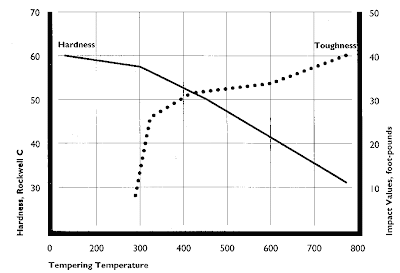Toughness and hardness
This one graph explains a great deal about the mechanics of the hardening and tempering of steel. "Hardness" is the resistance to denting. Glass is very hard, but also not very tough. "Toughness" is the ability to resist cracking. A pick axe is tough, so you can hit a rock with it and the axe won't shatter. It will dent and deform some, but most of the time for that application you don't care. Every alloy has its lines in a different spot, frequently the tempering temperatures listed in the materials specs are higher to get higher up on the toughness curve, so don't take the numbers as absolutes.
This comes from "New Edge of the Anvil" by Jack Andrews. It has a TON of great information and has substantially improved my understanding and skill with steel. Go check it out.
What this does show is that by popping your hardened piece in the tempering oven, there's a major improvement in crack resistance for a small loss in dent resistance. As your tempering temperature gets much higher, it's more like you're annealing the steel, taking it to a soft, malleable state. Note that these curves are most accurate for 10xx steels, with the xx in the 40 to 60 range, but it's about right for alloys like 4130 too.
Mild steel, by which I mean iron with a very small percentage of carbon, the typical stuff you'd buy at the hardware store, is generally pretty tough. You have to abuse it some to make it crack. But its hardness is down near the bottom of the curve here. So if you have a mild steel leg harness it's either pretty heavy, you pound dents out a lot, or you don't get hit much. You can make it a little harder by work hardening it, but as anyone who has cracked the corner of the fan on a cop knows, it starts to get brittle.
This comes from "New Edge of the Anvil" by Jack Andrews. It has a TON of great information and has substantially improved my understanding and skill with steel. Go check it out.
What this does show is that by popping your hardened piece in the tempering oven, there's a major improvement in crack resistance for a small loss in dent resistance. As your tempering temperature gets much higher, it's more like you're annealing the steel, taking it to a soft, malleable state. Note that these curves are most accurate for 10xx steels, with the xx in the 40 to 60 range, but it's about right for alloys like 4130 too.
Mild steel, by which I mean iron with a very small percentage of carbon, the typical stuff you'd buy at the hardware store, is generally pretty tough. You have to abuse it some to make it crack. But its hardness is down near the bottom of the curve here. So if you have a mild steel leg harness it's either pretty heavy, you pound dents out a lot, or you don't get hit much. You can make it a little harder by work hardening it, but as anyone who has cracked the corner of the fan on a cop knows, it starts to get brittle.


Comments